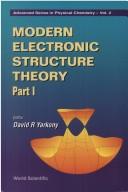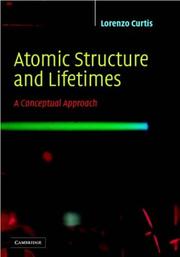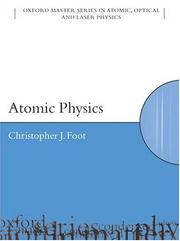| Listing 1 - 10 of 197 | << page >> |
Sort by
|
Book
ISBN: 9812832114 9789812832115 1299633250 9781299633254 Year: 1995 Volume: v. 2 Publisher: Singapore : World Scientific,
Abstract | Keywords | Export | Availability | Bookmark
 Loading...
Loading...Choose an application
- Reference Manager
- EndNote
- RefWorks (Direct export to RefWorks)
Modern Electronic Structure Theory provides a didactically oriented description of the latest computational techniques in electronic structure theory and their impact in several areas of chemistry. The book is aimed at first year graduate students or college seniors considering graduate study in computational chemistry, or researchers who wish to acquire a wider knowledge of this field.

ISBN: 9812832106 9789812832108 9810213182 9789810213183 9810221088 9789810221089 9810219598 9789810219598 9810229879 9789810229870 9810219601 9789810219604 9810229887 9789810229887 Year: 1995 Volume: v. 2 Publisher: Singapore ; River Edge, N.J. : World Scientific,
Abstract | Keywords | Export | Availability | Bookmark
 Loading...
Loading...Choose an application
- Reference Manager
- EndNote
- RefWorks (Direct export to RefWorks)
Modern Electronic Structure Theory provides a didactically oriented description of the latest computational techniques in electronic structure theory and their impact in several areas of chemistry. The book is aimed at first year graduate students or college seniors considering graduate study in computational chemistry, or researchers who wish to acquire a wider knowledge of this field.
Book
ISBN: 1634634675 9781634634670 9781634634205 1634634209 Year: 2015 Publisher: New York : Nova Publishers,
Abstract | Keywords | Export | Availability | Bookmark
 Loading...
Loading...Choose an application
- Reference Manager
- EndNote
- RefWorks (Direct export to RefWorks)
This book discovers four-dimensional space within a sphere with the instantiation of the 2s2p electron octet in a neon shell. Four space dimensions correspond to points, lines, planes, and solids geometrically. This book develops the idea of dynamic calculus that is implemented by circular functions instead of infinitesimal limits. As the law of nature, dynamic calculus of spherical quantities describes harmonic oscillations of electrons in atoms by dimension transformation rather than kinematic movement. In particular, electronic orbitals of 1s2s2p within a neon atom are defined in calculus,
Atomic structure --- Structure, Atomic --- Atomic theory --- Mathematical models.
Book
ISBN: 9781438471280 9781438471273 9781438471297 1438471297 1438471270 Year: 2018 Publisher: Albany : State University of New York,
Abstract | Keywords | Export | Availability | Bookmark
 Loading...
Loading...Choose an application
- Reference Manager
- EndNote
- RefWorks (Direct export to RefWorks)
French philosopher Gaston Bachelard (1884–1962) is best known in the English-speaking world for his work on poetics and the literary imagination, but much of his oeuvre is devoted to epistemology and the philosophy of science. Like Thomas Kuhn, whose work he anticipates by three decades, Bachelard examines the revolution taking place in scientific thought, but with particular attention to the philosophical implications of scientific practice. Atomistic Intuitions, published in 1933, considers past atomistic doctrines as a context for proposing a metaphysics for the scientific revolutions of the twentieth century. As his subtitle indicates, in this book Bachelard proposes a classification of atomistic intuitions as they are transformed over the course of history. More than a mere taxonomy, this exploration of atomistic doctrines since antiquity proves to be keenly pedagogical, leading to an enriched philosophical appreciation of modern subatomic physics and chemistry as sciences of axioms. Though focused on philosophy of science, the perspectives and intuitions Bachelard garnered through this work provide a unique and even essential key to understanding his extensive writings on the imagination. Roch C. Smith's translation and explanatory notes will help to make this aspect of Bachelard's thought accessible to a wider readership, particularly in such fields as aesthetics, literature, and history.
Philosophy of science --- Atomism. --- Atomic theory --- Philosophy --- Philosophy, Ancient --- Pluralism

ISBN: 1107138671 0511078765 9786612394034 1282394037 0511643543 0511205643 0511566530 0511755554 051107719X 9780511078767 9780511755552 9780511075650 0511075650 9780511077197 0521536359 9780521536356 0521829399 9780521829397 Year: 2003 Publisher: Cambridge ; New York : Cambridge University Press,
Abstract | Keywords | Export | Availability | Bookmark
 Loading...
Loading...Choose an application
- Reference Manager
- EndNote
- RefWorks (Direct export to RefWorks)
This book presents an approach to introductory graduate courses on atomic structure. The author's approach utilizes conceptually powerful semiclassical modeling methods, and demonstrates the degree to which the Maslov-indexed EBK quantization elucidates the quantum mechanical formulation of level energies and lifetimes. It merges this with an update and extension of semiempirical data systematizations developed by Bengt Edlén to describe complex atoms, and adapts them to include the specification of lifetimes. The text emphasizes the historical basis of the nomenclature and methodologies of spectroscopy. However, interaction mechanisms are presented deductively, based on quantum mechanical and field theoretical models, rather than tracing their indirect paths of discovery. Many worked examples provide applications to areas such as astrophysics, hyperfine structure, and coherent anisotropic excitation. The book presents a firm foundation for specialists in atomic physics, as well as a capstone application for specialists in astrophysics, chemistry, condensed matter, and other related fields.
Atomic structure. --- Atoms. --- Chemistry. --- Molecules. --- Physics --- Physical Sciences & Mathematics --- Atomic Physics --- Structure, Atomic --- Atomic theory

ISBN: 1282365665 9786612365669 0191523143 1435609670 9780191523144 9780198506966 0198506953 0198506961 9780198506959 6612365668 9781282365667 9781435609679 0191037079 1383021465 9780191037078 Year: 2023 Publisher: Oxford : Oxford University Press,
Abstract | Keywords | Export | Availability | Bookmark
 Loading...
Loading...Choose an application
- Reference Manager
- EndNote
- RefWorks (Direct export to RefWorks)
This modern text on atomic physics is suitable for students at advanced undergraduate level. It covers both the fundamentals of the subject, as well as cutting-edge developments of the past decade, and contains plenty of tutorial material, including examples, illustrations, summaries and graded problem sets.
Nuclear physics. --- Atomic theory. --- Chemistry, Physical and theoretical --- Atomic nuclei --- Atoms, Nuclei of --- Nucleus of the atom --- Physics --- Atoms.
Book
ISBN: 1282400649 9786612400643 9047425642 9789047425649 9789004172173 9004172173 9781282400641 6612400641 Year: 2009 Volume: 9 8 Publisher: Leiden ; Boston : Brill,
Abstract | Keywords | Export | Availability | Bookmark
 Loading...
Loading...Choose an application
- Reference Manager
- EndNote
- RefWorks (Direct export to RefWorks)
This book is the result of a collective attempt to give a general survey of the development of atomism and its critics in the late Middle Ages. All the contributors focussed on the thirteenth and fourteenth centuries atomists and anti-atomists, with a thorough examination of some important figures, as Nicholas of Autrecourt or John Wyclif, and lesser known as Gerard of Odo or William Crathorn for example. From those essays on particular authors a new way of understanding the discussions of atomism in late medieval philosophy and theology emerges. This volume demonstrates the existence of strong and complicated connections between natural philosophy, mathematics and theology in the medieval discussions of the atomistic hypothesis. All chapters present a new research that will be of interest to historians of medieval philosophy, science and theology. Contributors include: Joël Biard, Sander W. de Boer, Jean Celeyrette, Christophe Grellard, Elżbieta Jung, Emily Michael, John E. Murdoch, Robert Podkoński, Aurélien Robert, and Rega Wood. Medieval and Early Modern Science , 9
Atomism. --- Philosophy, Medieval. --- Medieval philosophy --- Scholasticism --- Atomic theory --- Philosophy --- Philosophy, Ancient --- Pluralism --- Atomism --- Philosophy, Medieval --- Atomisme --- Philosophie médiévale
Book
ISBN: 9400705336 9048123615 9786612237010 1282237012 9048123623 Year: 2009 Publisher: Dordrecht : Springer Science + Business Media,
Abstract | Keywords | Export | Availability | Bookmark
 Loading...
Loading...Choose an application
- Reference Manager
- EndNote
- RefWorks (Direct export to RefWorks)
Drawing on the results of his own scholarly research as well as that of others the author offers, for the first time, a comprehensive and documented history of theories of the atom from Democritus to the twentieth century. This is not history for its own sake. By critically reflecting on the various versions of atomic theories of the past the author is able to grapple with the question of what sets scientific knowledge apart from other kinds of knowledge, philosophical knowledge in particular. He thereby engages historically with issues concerning the nature and status of scientific knowledge that were dealt with in a more abstract way in his What Is This Thing Called Science?, a book that has been a standard text in philosophy of science for three decades and which is available in nineteen languages. Speculations about the fundamental structure of matter from Democritus to the seventeenth-century mechanical philosophers and beyond are construed as categorically distinct from atomic theories amenable to experimental investigation and support and as contributing little to the latter from a historical point of view. The thesis will provoke historians and philosophers of science alike and will require a revision of a range of standard views in the history of science and philosophy. The book is key reading for students and scholars in History and Philosophy of Science and will be instructive for and provide a challenge to philosophers, historians and scientists more generally.
Atomic theory -- History. --- Atomic theory. --- Atoms. --- Atomic theory --- Philosophy --- Physical & Theoretical Chemistry --- Philosophy & Religion --- Chemistry --- Physical Sciences & Mathematics --- History --- Atomism. --- Philosophy. --- History. --- Metaphysics. --- Philosophy and science. --- Physics. --- Philosophy of Science. --- History of Science. --- Philosophy, general. --- History of Philosophy. --- History and Philosophical Foundations of Physics. --- Chemistry, Physical and theoretical --- Philosophy, Ancient --- Pluralism --- Science --- Philosophy (General). --- God --- Ontology --- Philosophy of mind --- Annals --- Auxiliary sciences of history --- Normal science --- Philosophy of science --- Natural philosophy --- Philosophy, Natural --- Physical sciences --- Dynamics --- Mental philosophy --- Humanities --- Science and philosophy
Book
ISBN: 9781620817407 1620817403 9781620816288 1620816288 Year: 2012 Publisher: Hauppauge, N.Y. : Nova Science Publisher,
Abstract | Keywords | Export | Availability | Bookmark
 Loading...
Loading...Choose an application
- Reference Manager
- EndNote
- RefWorks (Direct export to RefWorks)
Atomic structure. --- Quantum gravity. --- Gravity, Quantum --- General relativity (Physics) --- Gravitation --- Quantum theory --- Structure, Atomic --- Atomic theory --- Skyrme, Tony Hilton Royle, --- Skyrme, T. H. R.
Book
ISBN: 3030683141 3030683133 Year: 2021 Publisher: Cham, Switzerland : Springer,
Abstract | Keywords | Export | Availability | Bookmark
 Loading...
Loading...Choose an application
- Reference Manager
- EndNote
- RefWorks (Direct export to RefWorks)
Atomic structure. --- Chemistry, Physical and theoretical. --- Molecular structure. --- Structure, Molecular --- Chemical structure --- Structural bioinformatics --- Chemistry, Theoretical --- Physical chemistry --- Theoretical chemistry --- Chemistry --- Structure, Atomic --- Atomic theory
| Listing 1 - 10 of 197 | << page >> |
Sort by
|

 Search
Search Feedback
Feedback About UniCat
About UniCat  Help
Help News
News